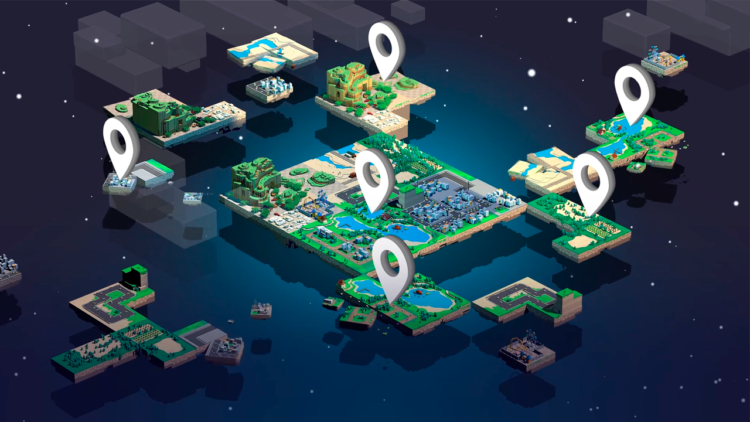In the metaverse, you can buy, sell, or build on a piece of virtual real estate, just like in the real world. However, everything is digital. In 2025, this digital reality is evolving quickly. The virtual land market is projected to grow to around $4.12 billion in 2025, and experts predict it could reach $67 billion by 2034, showing how fast this industry is growing…for context, that’s almost the size of Ghana’s economy.
Early Boom and Size Correction
The popularity of virtual land surged in 2021 and 2022, with people spending millions on parcels in worlds like Decentraland and The Sandbox and some even costing hundreds of thousands of dollars. However, after the hype, prices dropped, and by 2024, the average price per parcel had fallen from around $15,000 to approximately $3,000.
Despite this correction, virtual land remains valuable and investors are placing longer-term bets, seeing potential in digital spaces that offer real usefulness, not just hype.
What Makes Virtual Land Useful?
There are four ways to think about value in digital land:
First, you can own it like real property, which makes you part of a community, and other people might pay to visit or participate in events held in your space. The more popular your location, the more valuable your land becomes.
Second, you can build on it, with game worlds like Sandbox letting owners create virtual stores, event venues, or art galleries. You can even build games or social hangout spots, like centers at a real mall.
Third, you can earn from it, much like renting apartments, where you can let others use your land and charge them. This gives you land utility, which is a real and beneficial way to use your digital holdings.
Finally, brands and companies can get involved with big names like Nike, Gucci, and Meta, buying virtual land to reach online fans. This helps shape prices because land near these branded areas becomes more valuable
Major Platforms to Watch
Most virtual land transactions happen on just a few platforms:
- Decentraland allows you to create avatars, clothing, shops, and galleries. Back in 2021, top parcels sold for as much as $2.4 million

READ MORE: An Overview of Decentraland
- The Sandbox is popular among creators and brands and has plots owned by celebrities like Snoop Dogg and Deadmau5, and has sold millions in land in a single day.

- Other platforms, such as Cryptovoxels and Otherside, cater to artists and creative communities, growing steadily as well.
Together, these platforms control most of the land sales, making them the safest places to explore.
Prices and Speculation
Sometimes, virtual land prices can double or even triple within weeks, often based on excitement or company news. This is because these platforms are still new, and their values can fluctuate rapidly when someone launches a major build or brand project nearby.
Research also shows that buying land with local tokens (such as SAND) can result in a 3–4% premium compared to purchasing with Ethereum.
Who’s Buying Virtual Land?
These virtual land acquisitions are not exclusive to gamers or crypto fans: major companies and investors are also getting involved. Around 30% of virtual land buyers in 2022 were brands or institutions. Over 200 brands entered the scene that year, creating pop-up shops and hosting events virtually.
This shows that virtual land isn’t just for fun—it’s becoming a real part of business and marketing strategy.
Valuable Land vs Empty Plots
Interestingly, approximately 80% of virtual land remains unoccupied, with no buildings, events, or development. That means most spaces are still waiting for builders and creators to develop them, so there’s a huge chance to make empty land useful, and if someone sets up a virtual concert hall, a museum, or a game zone, they could stand out and increase the land’s value.
Challenges Ahead
While virtual land has exciting potential, it also poses some risks, as its success depends heavily on each platform’s popularity and community. If a platform fails, your land might lose value. Additionally, laws and taxes regarding virtual land are still unclear, and nobody fully understands the long-term value of digital assets.
Investing in virtual land requires careful consideration, just like in real estate, but it also opens doors to a new digital world where buildings and businesses can exist online.
What’s Next for Virtual Land?
Experts believe this is just the beginning, and forecasts suggest the market could grow more than 30% each year through to 2034. With better tech like VR/AR, more people will visit, build, and invest in these worlds.
Development tools are also improving, and soon, it will be easier for people with no coding experience to design virtual homes, shops, or meeting spots. This might help move virtual land from a niche hobby to a mainstream opportunity.
READ MORE: How To Buy Virtual Real Estate in the Metaverse
Virtual land in 2025 is a blend of excitement, speculation, and genuine utility, where virtual real estate meets creativity and community. As platforms grow, tools get better, and more people join, these digital lands will become places to work, play, and invest, whether for short-term gains or a quick turnover of profits.
Whether it’s buying a spot next to a celebrity’s parcel, building an immersive event, or renting out your property, virtual land markets are shaping a new frontier in Web3. In this digital land rush, the real value lies in the stories we build and the people who help bring them to life.
Disclaimer: This article is intended solely for informational purposes and should not be considered trading or investment advice. Nothing herein should be construed as financial, legal, or tax advice. Trading or investing in cryptocurrencies carries a considerable risk of financial loss. Always conduct due diligence.
If you want to read more market analyses like this one, visit DeFi Planet and follow us on Twitter, LinkedIn, Facebook, Instagram, and CoinMarketCap Community.
Take control of your crypto portfolio with MARKETS PRO, DeFi Planet’s suite of analytics tools.”





















